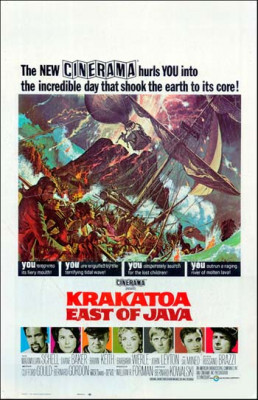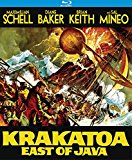| Reviews & Columns |
|
Reviews DVD TV on DVD Blu-ray 4K UHD International DVDs In Theaters Reviews by Studio Video Games Features Collector Series DVDs Easter Egg Database Interviews DVD Talk Radio Feature Articles Columns Anime Talk DVD Savant Horror DVDs The M.O.D. Squad Art House HD Talk Silent DVD
|
DVD Talk Forum |
|
|
| Resources |
|
DVD Price Search Customer Service #'s RCE Info Links |
|
Columns
|
|
|
Krakatoa East of Java
For some critics and audiences, the trivial geographical error in the title of Krakatoa East of Java (1969) was enough to invalidate the entire movie (Krakatoa is actually west of Java), a complaint that seems especially silly considering how many Americans can't find the United States on a world map.
The movie was one of the last films presented in Cinerama's deeply curved, 70mm single-projector process. By the time it was released, big downtown movie theaters were suddenly dying off fast, the result of "white flight" to the suburbs in the wake of race riots, changing distribution patterns (more suburban and multiplex theaters closer to home) and major aesthetic shifts in American cinema generally made Krakatoa seem like a relic even when it was new.
In fact, Krakatoa, while disjointed, is quite entertaining and genuinely impressive on big screens. Currently owned by Disney, as part of ABC's short-lived theatrical division (1965-73), Krakatoa, like its sister feature, the Cinerama released Custer of the West, has never really gotten a fair shake on home video, and while Kino's new Blu-ray is an improvement, it's still a long way from restoring the film to its original glory.
The story loosely revolves around the cataclysmic 1883 eruption of the volcanic Krakatoa island, a disaster that unleashed hot ash and 100-foot tsunami that killed more than 36,000 people, and whose explosions could be heard and felt 3,000 miles away.
In Anjer, on the west coast of Java, Captain Chris Hanson (Maximilian Schell) of the steamer ship Batavia Queen takes on passengers for what primarily is a salvage journey. Hanson's lover, Laura (Diane Baker), is married to an abusive husband who kidnapped her young son, but then was among the passengers aboard the steamer Arianna, which sank off the coast of Krakatoa with a fortune in pearls. Hanson intends to salvage the pearls and confirm the boy's death or survival.
He partners with diving bell designer Douglas Rigby (John Leyton), a claustrophobic (ironic, as Leyton played the POW who nursed Charles Bronson through his claustrophobia in The Great Escape); diver Harry Connerly (Brian Keith), who secretly suffers from a crippling lung disease and relies on the addictive laudanum; his mistress, Charley (Barbara Werle), a soprano and saloon hostess; hot-air balloon operators Giovanni Borghese (Rossano Brazzi) and his son, Leoncavallo (Sal Mineo); and four Japanese female pearl divers led by Toshi (Jacqui Chan), whom Leoncavallo is attracted to.
Just before setting sail, Hanson is ordered to take aboard a jailer and 30 prisoners bound for Madura, including Lester Danzig (J.D. Cannon), a former engineer aboard Hanson's ship.
Though directed by Bernard Kowalski, the real auteur of Krakatoa is French filmmaker Eugène Lourié, a former associate of Jean Renoir who on his own later directed special effects-heavy features like The Beast from 20,000 Fathoms (1953) and Gorgo (1961). By the late 1960s Lourié had returned to his first love, production design and special visual effects, providing such services to various big roadshows. (His last credit was Clint Eastwood's Bronco Billy in 1980.) Because the film was shot in 65mm (Super Panavision 70 and Todd-AO), Lourié was required to build extremely large and detailed miniatures, including an 18-foot model of the Batavia Queen filmed in a 300 x 400 foot water tank in Malta.
Probably in a move to gain financing, many of the film's special effects were shot before the script had been completed, its story built around the special effects rather than the other way around. Further, though initially conceived as a family film, when Cinerama and Pacific Theaters and/or ABC became involved, more adult elements were added, which account for the somewhat disjointed storytelling and rather arbitrary fate of some of the characters.
But the special effects really deliver. By 1969 standards they were eye-popping if a bit wearying toward the end. (Krakatoa erupts impressively but endlessly, like a fireworks factory in flames.) The miniatures are so good that in some shots they're hard to distinguish from the full-size vintage steamer used, though mostly they're recognized as such, but still extremely impressive and evocatively lit and photographed.
As a movie Krakatoa isn't exactly Ibsen but it's far superior to most of producer Irwin Allen's subsequent disaster epics. The cast is appealing: Werle is fine in a rare film role, Baker is lovely to look at, and J.D. Cannon is very good in an atypical role.
Video & Audio
As with Kino's Custer of the West, the Blu-ray of Krakatoa East of Java is far from perfect. The former, filmed in Super Technirama 70, looked great 80% of the time, but for the other 20% appeared to utilize up-rezz standard-def material cut out for the general release version. This release of Krakatoa appears sourced from a 35mm general release version, rather than from the original 65mm negative. No cinematographic process is listed in the credits, and the transfer is in 2.35:1 ‘scope rather than 2.20:1 Super Panavision. And, like Custer of the West, the audio is underwhelming (if DTS-HD) mono, unlike the original 6-track magnetic stereo release, which really must have been something back in 1969.
Nonetheless, even from this print-down version, the image is sharper than most native ‘scope titles from the period, though even it shows signs of damage here and there. It's too bad the immersive qualities of 70mm Cinerama aren't adequately reproduced here and there are some impressive you-are-in-the-picture type shots. Even the triptych opening harkens back to the glory days of three-panel Cinerama. Region A encoded, with optional English subtitles. No Extra Features.
Parting Thoughts
Krakatoa East of Java exemplifies the struggle roadshow producers encountered as tastes and distribution patterns changed, making long and successful runs of big scale features much harder to come by. It's an imperfect but strangely likeable film, imperfectly presented here but still Recommended.
Stuart Galbraith IV is the Kyoto-based film historian largely absent from reviewing these days while he restores a 200-year-old Japanese farmhouse.
|
| Popular Reviews |
| Sponsored Links |
|
|
| Sponsored Links |
|
|
| Release List | Reviews | Shop | Newsletter | Forum | DVD Giveaways | Blu-Ray | Advertise |
|
Copyright 2024 DVDTalk.com All Rights Reserved. Legal Info, Privacy Policy, Terms of Use,
Manage Preferences,
Your Privacy Choices | |||||||















